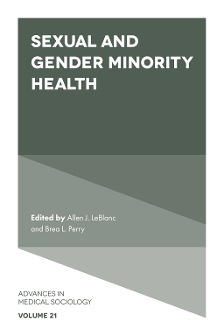
Index
Sexual and Gender Minority Health
ISBN: 978-1-83867-147-1, eISBN: 978-1-83867-146-4
ISSN: 1057-6290
Publication date: 15 January 2021
Citation
(2021), "Index", LeBlanc, A.J. and Perry, B.L. (Ed.) Sexual and Gender Minority Health (Advances in Medical Sociology, Vol. 21), Emerald Publishing Limited, Leeds, pp. 321-327. https://doi.org/10.1108/S1057-629020210000021004
Publisher
:Emerald Publishing Limited
Copyright © 2021 Emerald Publishing Limited
INDEX
- Prelims
- Research on Sexual and Gender Minority Health: Historical Developments and Future Directions
- Part I Health Disparities: Risk Factors, Minority Stress, and Intersectionality
- Sexual and Gender Minority Health: Toward a More Complete Accounting of Social Class
- Substance Use, Mental Well-being, and Suicide Ideation by Sexual Orientation among US Adults
- State-level Policy, School Victimization, and Suicide Risk among Sexual Minority Youth
- Understanding Fear of Deportation and Its Impact on Healthcare Access among Immigrant Latinx Men Who Have Sex with Men
- Part II Resilience and Resistance: Identity, Social Relationships, and Community
- Social Biographies and Health Among Sexual and Gender Minority People
- Life Course Transitions, Personal Networks, and Social Support for LGBTQ+ Elders: Implications for Physical and Mental Health
- Experiences of Gender and Sexual Minority Stress Among LGBTQ Families: The Role of Community Resilience and Minority Coping
- Resisting and Reframing Explanations for “Lesbian Obesity”: LBTQA+ Young Women's Narratives of Sexual Identity as a Protective Factor
- Part III The Role of Institutions: Healthcare and Social Service Systems
- How Healthcare Providers Hold Trans Patients Accountable to Medical Authority
- “Every Now and Then I Get Flagged for a Pap Smear”: Gender Transition, Embodiment, and “Sex-Specific” Cancer Screenings
- “Oh You Should Talk to…”: The Implementation of LGBTQ Health Curricula in Medical Education
- “What Are We Going to Do with a Penis in the Room?”: Rape Crisis Centers and Treatment of Transgender Survivors
- Index